Château Duhart-Milon

The Estate
In the early 18th century, the Pauillac district began widespread grape cultivation at the urging of the owners of Château Lafite Rothschild. The wines produced by Mandavy-Milon (former name of Duhart-Milon) served as additional income for Marquis Nicolas-Alexandre de Ségur (Lafite’s owner), and became Château Lafite’s second wine. Early on, the soil was acknowledged as being of particularly high quality.
In 1815, knowledgeable people were already talking about Mandavy-Milon as a fourth growth Pauillac wine in the making. Between 1830 and 1840, the Castéja family was left an inheritance of 40 hectares of vines by both Mandavy and the Duhart widow, which ended up being named Duhart-Milon. The oral tradition is that “Sieur Duhart” was the name of a privateer under Louis XV who settled in Pauillac on his retirement. The privateer’s house in the port of Pauillac existed up to the 1950’s and inspired the label for the Duhart-Milon wines.
The 1855 classification recognized the quality of Duhart-Milon’s terroir by ranking it as the only 4th growth wine in Pauillac. Château Duhart-Milon was then one of largest Pauillac estates with around 50 hectares.
In 1937, the result of successive inheritances led to the sale of the estate. The property went through 5 different owners in just 25 years, and the splitting up of the vineyards caused a speedy decline, which was only made worse by the severe frost of 1956. The quality of the Château’s wines declined considerably until the Rothschild family purchased the property in 1962. Duhart-Milon then consisted of 110 hectares, of which only 17 hectares were vines. Major construction projects were then undertaken in the vineyard: draining, uprooting, replanting, the purchase of adjacent plots, and reintegrating the vineyard by trading plots. New cellar and vat rooms were installed in Pauillac. From 1973 to 2001, the vineyard increased from 42 ha to 71 ha.
Today, the new vines are all mature, and the renovation of the cellar adds a finishing touch to a remarkable 40-year effort that has restored Château Duhart-Milon to its Médoc 4th growth rank.

Château Duhart-Milon 4ème Grand Cru Classé
Overview: Château Duhart-Milon’s grand vin is often described as a model of the Pauillac appellation. The broker Guillaume Lawton noted as early as 1815 that “it is very robust, with a fine colour, and quite pronounced sappiness” (he describes the “sappiness” of the Médoc’s premiers crus as “something like the odour given off by finest sealing wax when it is burned”).
Management: The property has been managed since 1962 by a single team that, due to the proximity of the two properties, oversees both Château Lafite Rothschild and Château Duhart-Milon. Eric Kohler, Technical Director of the Bordeaux Châteaus, is assisted by Oenologist and Winemaker Christophe Congé, and Vineyard Manager Louis Caillard.
Production Area: Château Duhart-Milon’s vineyard consists mainly of a single block of vines on the west side of Château Lafite Rothschild, on the Milon hillside, which runs along the Carruades plateau. The property has 76 hectares of vine.
Soil: Fine gravel mixed with aeolian sand on tertiary limestone subsoil.
Average Age of the Vines: 30 years old
Grape Varieties: 65-80% Cabernet Sauvignon, 20-35% Merlot.
Harvest: Manual, with strict control of yields
Aging: In oak barrels for 14 months (50% new wood). The wines are periodically racked and fined with egg whites.
Average Annual Production: About 30,000 cases
Decanting: 2 hours or more
Tasting Temperature: 16-18 °C
1999 Reviews: “Quite pale. Toasty, rather sophisticated nose. A ballet dancer. Light, though not disappointingly light. A very distinctive, un-modern style.” – 16.5pts (Distinguished +), Jancis Robinson
Château Durfort-Vivens (Biodynamic)
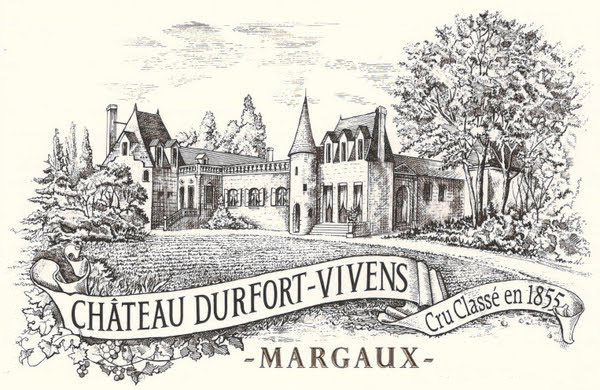
The Estate
Chateau Durfort Vivens takes its name from two of its previous owners: the Durfort de Duras family from southwest France, and the Viscount de Vivens. The estate has been highly regarded since the 19th century, with icons such as Thomas Jefferson (future president of the US and Bordeaux connoisseur) ranking it directly after Chateau Lafite Rothschild, Chateau Latour, and Chateau Margaux.
The property has been owned and managed by the Lurton family since 1961. Before that time, the wines of Durfort-Vivens were made at Chateau Margaux. In 1992, Gonzague Lurton took ownership of the estate and proceeded to modernize the cellars and fermentation vats. Beginning with the 2009 vintage, Lurton began to produce a riper and more concentrated style of wine at Durfort Vivens and also started to experiment with organic farming techniques. By the 2013 harvest, the estate became 100% organically and Biodynamically farmed. They received their certification for biodynamic and organic farming in 2016 from Ecocert and Biodyvin. This made Chateau Durfort the first classified growth in the Margaux appellation to be Demeter certified as being 100% biodynamic.

Château Durfort-Vivens Margaux 2ème Grand Cru Classé
Owner: Gonzague Lurton
Director: Jérôme Héranval
A.O.C.: Margaux
Classification: Second Grand Cru Classé in 1855
Production Area: 65 hectares of which 55 are vines
Soil: Deep gravel from the Quaternary period (Günz and Mindel) with a sand/clay matrix
Grape Varieties: 70% Cabernet-Sauvignon; 24% Merlot; 6% Cabernet-Franc
Plant Density: 6,600 to 8,300 vines/hectare
Vinification: Wooden and concrete vats with capacities that enable each parcel to be treated separately
Aging: An average of 18 months in Bordeaux type barrels made from fine grain oak from the forests of central France. 45-50% of the barrels are renewed every year
Château Faugères
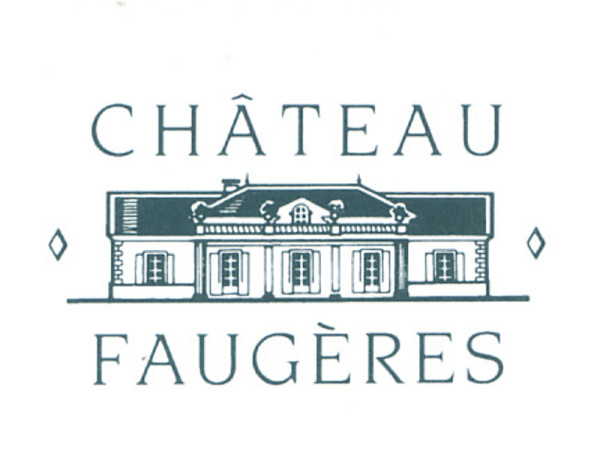
The Estate
Established in the early 19th century, Château Faugères was owned by the Esquissaud family for about 160 years. It was not until 2005, however, when Faugères was bought by perfume entrepreneur, Silvio Denz, that the estate began to get notoriety for its high quality wines. Denz completely renovated the estate, including the wine making facilities, and today it is a sight to be seen, with its visually impressive architecture designed by Mario Botta.

Château Faugères Saint-Émilion
Appellation: Saint-Émilion Grand Cru
Production Area: 37 ha
Grape Varieties: 85% Merlot, 10% Cabernet Franc, 5% Cabernet Sauvignon
Soil: Limestone plateau (asteria limestone subsoil) dating back to the upper Oligocene; limestone and clay slope (limestone soil on clay-limestone molasse) dating back to the upper Eocene and Oligocene
Average Age of the Vines: 35 years old
Plantation Density: 6,000 vines/ha
Cultivation & Harvesting: “Guyot double” pruning, plowing and inter-row grassing, debudding, thinning by hand, manual harvesting using trays, sorting tables, with one for optical sorting
Environmental Integrity: Natural sustainable viticulture. ISO 14001 environmental certification obtained in 2009
Vinification: Vats filled by gravity, cold prefermentary maceration, temperature-controlled wooden conical vats, 50% of the malolactic fermentation in new barrels, slow vatting over a period of 3 weeks
Consultant Oenologist: Michel Rolland
Maturing: 50% in new French oak barrels, 50% in old wine barrels, for 14 months
Average Production: 65,000 bottles
2015 Reviews: “Smooth and opulent, this is a densely tannic wine. Its dark fruits and dusty texture are backed by juicy acidity and a core of framing tannins. It will be powerful and rich with age.”-94pts, Wine Enthusiast
Chateau Ferran
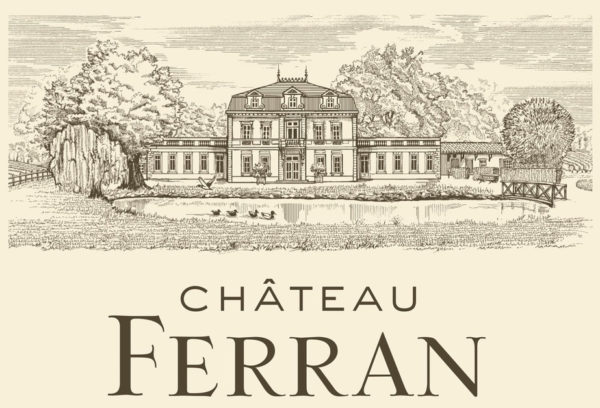
The Estate
The vineyards at Chateau Ferran were planted on the Martillac plateau in the 18th century by the renowned philosopher Montesquieu. Named after Robert de Ferran, a solicitor at the Bordeaux Parliament, this terroir has always produced both red and white wines which were then known as “Premiers Graves Martillac.” The property has belonged to an old Bordelais family since 1880, and today their descendants-Philippe and Ghislane Lacoste-have been managing the estate since 1999. A lot of work has been done in recent years to restructure the vineyard and renovate the cellars.

Château Ferran Rouge Pessac-Léognan
Production Area: 19-hectares for the red wine
Soil: Slightly gravelly Miocene clay-limestone ridges
Plant Density: 7,140 plants per hectares
Grape Varieties Planted: Merlot, Cabernet Sauvignon, and Petit Verdot for the red varieties.
Annual Production: About 7,000 cases for the red wine
Harvest: Hand picking, strict sorting of the crop on the vine and in the cellar.
Vinification: In stainless steel, thermoregulated tanks.
Aging: Stave oak barrels (30% new wood).
Oenologist: Christophe Ollivier
Technical Manager: Pierre-Hubert Gory
Château Ferrière (Organic)
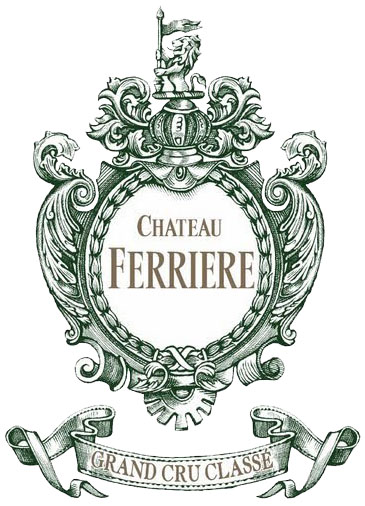
The Estate
In the middle of the XVIII century, the property belonged to Gabriel Ferrière, illustrious member of the court of Louis XV. It remained in the family until 1914, when it was sold to Armand Feuillerat, the owner of Chateau Marquis de Terme, another Grand Cru Classé of Margaux. From 1952, the property was rented and the operations were directed by Alexis Lichine. The wine was vinified at Chateau Lascombes. In 1988, the Villars family bought the vineyards and the château, but the long term rent only ended in 1992. The family then took over the operations of the vineyard and winemaking. With its 12 hectares of vineyards, Chateau Ferriere has the smallest property of the Grands Crus Classés in 1855. Today, Claire Villars‐Lurton is at the origin of this revival. She works with the greatest fineness and succeeded to reveal in her wine the exceptional terroir of Chateau Ferriere.

Château Ferrière Margaux 3eme Grand Cru Classé
Owner: Claire Villars Lurton
Production Manager: Gérard Fenouillet
Consultant: Jacques Boissenot
Production Area: 12 hectares
Soil: Deep gravels on limestone substrate
Grape Varieties: 70% Cabernet Sauvignon, 30% Merlot
Average Age of the Vines: 45 years
Plant Density: 10,000 plants/ha
Yield: 700 to 800 g/plant
Cultivation: Traditional‐Integrated wine growing management
Harvest: Hand picking
Vinification: Traditional in concrete and wooden vats, whose volumes are proportional to the plots. Fermentation on skins for 16 to 26 days.
Aging: In oak barrels for 18 months. 40% new oak.
Annual Production: 50,000 bottles, including the second wine
Tasting Notes: The color is deep. The nose is elegant and fluid with aromas of black truffle, mocha and tobacco but it is still fruity. The attack is beautiful. It is a powerful wine with long, elegant and fresh tannins. The wine is very elegant.
Château Fleur Cardinale
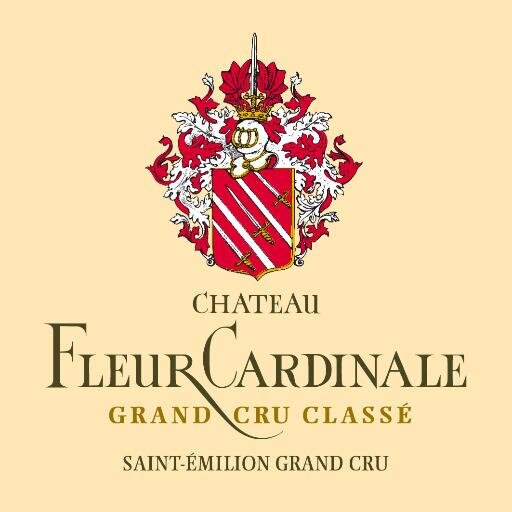
The Estate
The first evidence of an estate producing its own wine here dates back to the 1920s-1930s, following the marriage of Pierre Sarthou-Moutengou and Jeanne Marie Grué, a descendent of two families of vineyard owners. The Château was called “Clos Bel-Air” back in those days. The estate owes its current name, Château Fleur Cardinale, to Jean-Louis Obissier, son of the mayor of Villerouge-Termenes who purchased Clos Bel-Air in 1975. It is said that the Obissier family owned race horses at the time, by the names of Fleur and Cardinale. After the death of his race horses, Mr. Obissier changed the name of the estate to Château Fleur Cardinale.
After producing porcelain in Limoges for 27 years as the owner of several companies (including Haviland), Dominique Decoster decided to sell all his businesses in 2000. In May 2001, Dominique and his wife Florence decided to buy Château Fleur Cardinale from the Asséo family who had owned the estate since 1982. The family was drawn to the quality of life here and the welcome they received from those in the wine trade. To succeed in this new project, they felt it would be best to live on the estate, so they decided to take up permanent residence at Château Fleur Cardinale along with their three children: Ludovic, Matthew and Lucie. In addition to its activities, the property now also became a family home.
As soon as they arrived in 2001, Florence and Dominique decided to keep the team that had been working there for several years and surround themselves with knowledgeable advisers: an agricultural engineer, an oenologist, and their neighbor Jean-Luc Thunevin, the owner of Château Valandraud, who is now the estate’s general consultant. Aware of the potential improvements that could be made to the estate, they together defined priority investments in the vineyard, including uprooting the plots that did not meet their standards and reducing yields. They acquired new equipment and soon decided to build a new winery, inaugurated in 2002, allowing them to carry out plot-by-plot fermentation and ensure the traceability of each batch. These strategic decisions earned Château Fleur Cardinale the rank of Saint-Emilion Grand Cru Classé in 2006.
In 2012, the estate’s rank was confirmed. The same year, their daughter-in-law Caroline decided to join the adventure. A graduate of the KEDGE Wine and Spirits Management Masters programme with a university diploma in wine tasting in 2013, she is now the estate’s Sales and Marketing Director. In 2015, Ludovic joined the team after spending nearly ten years working for the SOBOVI trading house, as Sales Manager and then Export Sales Director. Today, Ludovic is the Estate Manager and is responsible for carrying on the remarkable work initiated by his parents.

Château Fleur Cardinale Saint-Émilion Grand Cru Classé
Appellation: Saint-Emilion Grand Cru
Classification: Grand Cru Classé
First Vintage of the Decoster Family: 2001
Production Area: 23.5 hectares (58.07 acres); 57 plots
Plant Density: 6225 / 8000 vines / ha (old / young plants)
Soils: Clay and limestone, 7 types of soils: Brunisols issus de la Molasse du Fronsadais, Calcisols issus de la Molasse du Fronsadais, Calcisols issus de la Molasse de l’Agenais, Calcosols issus de la Molasse du Fronsadais, Calcosols sur Calcaires à Astéries, Calcosols issus d’argiles vertes à nodules calcaires, Colluviosols calcaires
Grape Varieties Planted: 76% Merlot, 18% Cabernet Franc, 6% Cabernet Sauvignon
Average Age of the Vines: 38 years old
Environmental Certifications: Member of the first association of the Environmental Management System (S.M.E.) for the Wines of Bordeaux, certified ISO 14001 since 2013. High Environmental Value (HEV) since 2017.
Harvest: Manual, in small crates
Vinification: Stainless steel vats
Aging: 12 to 14 months – new French oak
Average Production: 110,000 bottles
Tasting Notes: A wine with a deep, concentrated color. The bouquet is equally delightful, with its intense range of aromas dominated by ripe fruit with floral and spicy overtones. This wine is charmingly balanced and generous on the palate with perfectly smooth tannins. The finish is long and aromatic. In short, a wine with an astonishing personality, embodying both power and elegance.
2009 Reviews: “A good value among over-achieving St.-Emilion estates is La Fleur Cardinale’s 2009. Composed of 70% Merlot, 20% Cabernet Franc and 10% Cabernet Sauvignon, some of the abrasive tannins noticeable early on in this big wine (14.5% alcohol) are now sweeter and better integrated. Made from tiny yields of 30 hectoliters per hectare, this is a concentrated, rich effort revealing lots of black cherry and black currant fruit as well as a fragrant, firm, full-bodied personality.” – 94pts, Robert Parker
Château Fombrauge
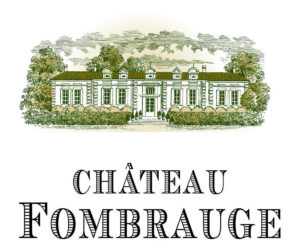
The Estate
Château Fombrauge goes back to the 16th century, which makes it one of the oldest châteaux in the Saint Emilion region. The beautiful 17th century old country manor was originally the cloister of the town’s Carthusian Monastery. Owned by Jacques de Canolle in 1466, the estate later belonged to the Dumas de Fombrauge family, who implemented the first quality wine making in the estate in the 18th century.

Château Fombrauge Saint-Émilion Grand Cru Classé
Appellation: Saint-Emilion Grand Cru
Location: Saint Christophe des Bardes
Production Area: 58 hectares
Grape Varieties Planted: 89% Merlot, 8% Cabernet Franc, 2% Malbec, 1% Cabernet Sauvignon
Average Age of the Vines: 35 years old
Plant Density: 6,500 vines per hectare
Soil: Clay and limestone with Fronsac molasses
Cultivation: Parcel based management (grass covering, ploughing). Shoot removal at beginning of June. 1st thinning out of the leaves in July. 2nd thinning out of the leaves in September.
Vinification: Parcel selection per terroir, grape variety and age of the vines. Selection inside the parcels thanks to relevant information on maturity and vine strength provided by the drone.
Harvest: In small crates. Sorting on a table before and after destemming by 20 qualified people
Vinification: Vatting in small capacity wooden tanks (70 hectoliters) by gravity flow. Pre-fermentation maceration for 4-8 days at 8°C. Manual punching down. Maceration for 28-32 days for the Merlot, 26-28 days for the Cabernet
Aging: 18 months in 45% new oak barrels, 45% one year-old barrels, 10% in state-of-the-art cement tanks
Average Yield: 38 hl per hectare
Consulting Enologist: Michel Rolland
2015 Reviews: “Medium to deep garnet-purple in color, the 2015 Fombrauge offers up aromas of baked berries, dried mulberries and preserved plums with touches of Indian spices and game. Medium to full-bodied with loads of expressive fruit, it has firm, grainy tannins and finishes with a lively lift.” – 92pts, Wine Advocate

Prélude de Fombrauge Saint-Émilion
Appellation: Saint-Emilion Grand Cru
Location: Saint Christophe des Bardes
Production Area: 58 hectares
Grape Varieties: 89% Merlot, 8% Cabernet Franc, 2% Malbec, 1% Cabernet Sauvignon (percentages vary depending on the vintage)
Age of the Vines: 35 years
Plant Density: 6,500 vines per hectare
Soil: Clay and limestone with Fronsac molasses
Viticulture: Parcel based management (grass covering, plowing); shoot removal at beginning of June (1st thinning out of the leaves in July, 2nd thinning out of the leaves in September)
Harvest: Parcel selection per terroir, grape variety and age of the vines. Selection inside the parcels thanks to relevant information on maturity and vine strength provided by the drone. Harvest in small crates. Sorting on a table before and after destemming by 20 qualified people.
Vinification: Vatting in small capacity wooden tanks (70 hectoliters) by gravity flow. Pre-fermentation maceration for 4-8 days at 8°C. Manual punching down. Maceration for 28-32 days for the Merlot, 26-28 days for the Cabernet.
Aging: 15 months in new oak barrels and in state-of-the-art cement tank.
Average Yield: 38 hl/ha
Consulting Enologist: Michel Rolland
2016 Reviews: “The 2016 Prélude de Fombrauge has a medium garnet-purple color and a lovely nose of black and red plums, warm blueberries and tobacco with a waft of sautéed herbs. Medium to full-bodied, the palate is wonderfully savory with impressive poise and a velvety texture to the finish.” – 89pts, Wine Advocate
Château Fonroque (Biodynamic)
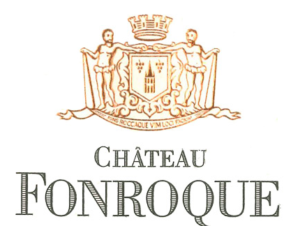 History
History
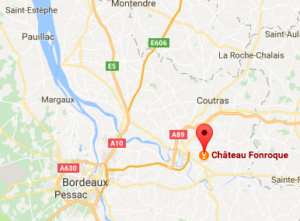
Château Fonroque is the birthplace of the Moueix family in Saint-Emilion. This property was bought in 1931 by Jean and Adèle, the great grandparents of Alain Moueix, who is now director of this lovely wine estate. When Jean-Antoine died in 1979, the firm Etablissements Jean-Pierre Moueix (a family-owned, Libourne wine trade firm) was entrusted with the running of this estate. The vineyard was managed on the basis of a programme of regular replanting and drainage work. The method of green harvesting, especially for young vines, is used systematically. Alain Moueix was appointed to manage this family estate in 2001. Each generation makes its mark, and Alain clearly adheres to this tradition. Thanks to his training as an agricultural engineer-oenologist and endowed with wine-producing experience gained in France as well as abroad, he made the carefully considered decision to pass Château Fonroque over to “organic” methods as of 2002. Verifications to obtain certification began in 2003. The vines at Fonroque now react to biodynamics, and this means the wines produced are more authentic.
The Terroir
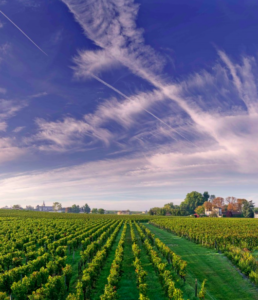 The Fonroque estate stretches its 20 hectares over several hundred metres to the north-west of the village of Saint-Emilion. The vineyard covers 17.6 hectares in a single piece of land that spreads across a plateau and a west-facing hillside. Neighbouring estates are principally classified growths: Château Laniote to the West, Château Cap de Mourlin to the North, Château Moulin du Cadet and Cadet Piolat to the East, Château Clos Fourtet on the Southern slope.
The Fonroque estate stretches its 20 hectares over several hundred metres to the north-west of the village of Saint-Emilion. The vineyard covers 17.6 hectares in a single piece of land that spreads across a plateau and a west-facing hillside. Neighbouring estates are principally classified growths: Château Laniote to the West, Château Cap de Mourlin to the North, Château Moulin du Cadet and Cadet Piolat to the East, Château Clos Fourtet on the Southern slope.
In the Fonroque vineyard, we find this type of lay out:
- The plateau: relatively shallow soils with the presence of a slab of limestone close to the surface
- The hillside: a majority of clay-limestone soils
- The foot of the hillside: limestone is less present
As soon as management of the estate was taken over, a programme to restructure the vineyard was established over a period of 10 years. A request for Organic Viticulture certification was launched in 2003 and subsequently the 2006 harvest was certified “AB” (Agriculture Biologique – Organic Agriculture/Viticulture).
Concurrently and gradually, biodynamic methods were also started and implemented throughout the vineyard as of 2004. Fonroque joined the Association of Winegrowers using
Biodynamic methods “BIODYVIN” as of 2005.
Vinification
At Château Fonroque, plots of Cabernet Franc grown on soils containing a majority of limestone bring elegance, length and structure to the wines; these elements also offset the natural roundness and generosity of Merlot. The reasoning applied to organic viticulture is naturally consistent with procedures for harvesting (hand-picked) and winemaking.
Obtaining increasingly rich grapes, the use of the barrel must enable the wine to reveal its true expression, without being overpowered by the wood: in this way it preserves all its freshness during the next eighteen months.
Château Cartier, the estate’s second wine, is made with batches whose finish is slightly less long and minerality not quite as distinct. The second wine represents 30% of the total harvest.

Château Fonroque Saint-Émilion
Overview: Certified organic since 2006 and certified biodynamic since 2008. The wines of Chateau Fonroque are naturally rich and beautifully refined on the palate, with delectable freshness and much elegance.
Manager: Alain Moueix
Technical Manager: Laurent Nougaro
Production Area: 17.6 hectares
Terroir: Limestone on the plateau, clay and limestone on the hillside
Grape Varieties: 80% Merlot, 20% Cabernet Franc
Average Age of the Vines: 35 years
Average Yield: 40 hl/ha
Average Production: 50,000-70,000 bottles
Harvest: Manual harvest into “cagettes.” Extremely thorough sorting of the grapes before placing in vats.
Vinification: Fermentation in concrete vats, thermo-regulated according to the terroir, the age of the vines, and the grape varieties. Slow and gentle extraction, modulated to each cuvée.
Aging: In oak barrels (30% new wood, 70% one year old +) or in small volume tanks
Tasting Notes: The wines of Fonroque are naturally rich and racy. The clay terroir gives them strength and profundity. The limestone gives them a definite mineral quality. There is a lovely freshness on the palate, with much elegance and refinement. Its length foreshadows a substantial cellaring potential.
Château Fourcas Dupré
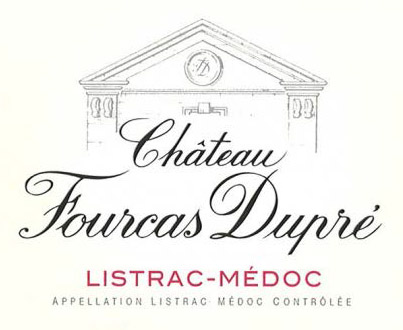
Overview
The vineyards of Fourcas were first referenced on a map designed by Belleyme, who was the geographical engineer of Louis XV. In 1843, the lawyer Jean Baptiste Antoine Dupré, a member of the Bordeaux Appeal Court, acquired the vineyard, and in 1844 Château Fourcas Dupré was born. The cellars, buildings, as well as the château itself were completely renovated. Today, a new, fully-functioning fermenting room and refurbished cellars for storing and packing complement the original rooms. The château now belongs to a family-owned company managed by Patrice Pagès.

Château Fourcas Dupré Listrac-Médoc
Location: The vineyard of Château Fourcas Dupré is located on a crest of Pyrenean gravely soil at an altitude of 42 meters above sea level. It is an uninterrupted plot with an average density of 8,500 vines per hectare. These days, the winemakers use traditional methods (vineyard draining, limited production, etc.) are employed to produce wines that perfectly represent this unique terroir.
Wine Production: In his quest for a perfectly ripe harvest, the cellar master, thanks to a fermentation cellar which is entirely temperature controlled, can show the character of the four grape varieties that compose the wine of Château Fourcas Dupré. Aging in barrels, a third of which are renewed every year, completes the balance of every vintage year.
Owner: Patrice Pagès
Appellation: Listrac-Médoc
Area Under Vine: 46 hectares
Production: 240,000 bottles of Château Fourcas Dupré
Soil: Pyrenean gravel on clay hardpan subsoil
Grape Varietals: 44% Merlot, 44% Cabernet Sauvignon, 10% Cabernet Franc, 2% Petit Verdot
Yield: 49 of 54 hl/ha
Aging: 12 months in barrel, 1/3 new each year
2015 Reviews: “…plenty of blackberry and boysenberry fruit on the nose, a touch of brine here, a subtle marine influence that lends it complexity and personality. The palate is medium-bodied with a juicy opening, a melange of red and black fruit, taut and quite linear with plenty of freshness and tension on the finish. This is a well-crafted Listrac that punches well above my expectations.”-93pts, Wine Advocate
2014 Reviews: “The wine is ripe and full of blackberry fruits. It has serious tannins still although these are well balanced by the fruitiness. The firm structure and wood aging flavor will soften over the next few years. Drink from 2020.” – 91pts, Wine Enthusiast
2012 Reviews: “Mid cherry red. Lovely cherry fragrance too. Cool and silky. Relatively lightweight but fine and gentle on the palate. Pretty and elegant. The producer was worried that this was a lighter-tasting sample than the rest and the second bottle was indeed firmer and richer. Bravo.” – 16.5pts, Jancis Robinson
Chateau Franc Laporte
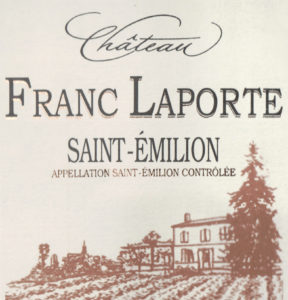
The Estate
Chateau Franc Laporte has been a family-owned property for 4 generations. It is currently managed by Michel Rollet, a retired mathematics professor. This estate is located on the clay and limestone plateau of Saint-Emilion known for creating wines with smooth, round tannins, red fruit flavors, and spicy notes.

Château Franc Laporte Saint-Emilion
Production Area: 5.5 ha planted with red vines
Grape Varieties: 90% Merlot, 10% Cabernet Franc
Annual Production: 35,000 bottles
Harvest: Manual harvest with sorting in the vineyard and the cellar.
Vinification: Traditional vinification in stainless steel vats with controlled temperature.
Aging: In vats and French oak barrels (70%)
Tasting Notes: A deep purple color with red berry notes. Full-bodied with ripe, rich fruit aromas and a silky structure. Very pleasant wine to drink with dinner.
Château Gazin
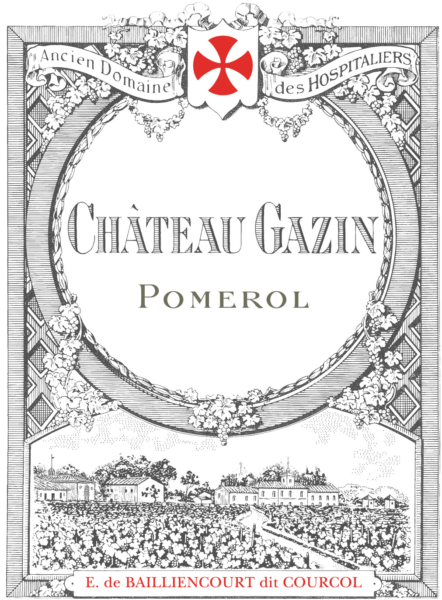
The Estate
The owners of Chateau Gazin are Laure (Madame Michel Dufour), Christophe, Inès, and Nicolas de Bailliencourt. These descendants of Louis Soualle represent the 5th generation of vineyard owners both on the paternal and maternal side. Descended from the high lords of Landas, whose crest they bear, the Bailliencourt dit Courcols belong to one of the oldest families of the Artois (north of France). The addition of “dit Courcols” or “known as Courcol” goes back to 1214, when Philippe-Auguste, the King of France, congratulated one of the members of the family for his exploits during the Battle of Bouvines, calling him “court col” (literally “short neck” or of compact build). The family motto became: “fut par vertu Courcol” (Courcol through virtue).
Château Gazin, which was a hamlet in the 18th century, is probably located on the site of the “Hospital of Pomeyrols”, built by the knights to receive pilgrims on the Santiago de Compostela route. This was the inspiration for the name of the property’s second wine “l’Hospitalet de Gazin”.

Château Gazin Pomerol
Production Area: 26 ha
Location: One plot located on the high terrace of the terroir of Pomerol
Terroir: Günzian gravels with a subsoil of blue and green clays including iron oxides. These clays (smectites) allow a regular and moderate supply of the vine in water, characteristic of great terroirs. The clay-gravelly subsoil of the Pomerol plateau is the essence of the terroir of Château Gazin.
Average Age of the Vines: 35 years old
Plant Density: 5,500 – 7,000 feet per hectare
Cultivation: The vines are cultivated in traditional ways with respect for the environment: plowing, organic fertilizers, reasoned fight against vine pests “sexual confusion”, manual harvesting.
Harvest: Manually done, carried out plot by plot, at perfect maturity. The grapes undergo a first sorting in the vineyard, done by the grape harvesters. In the vat room two sorts are made, before and after the separation of the stalks, to optimize the quality of the fruits.
Vinification: Alcoholic fermentations are made in small concrete vats, grape varieties and parcel per plot, before a period of maceration of the juices with the skins, for 2-3 weeks. Then comes the draining of the wines and the pressing of the marcs whose juices are carefully set apart. The second fermentation – malolactic – is then carried out, according to the quality of the batches of wine, in barrels or in vats, varietal grape variety.
Aging: In oak barrels (50% new wood) for 18 months. Racking every three months.
Annual Production: Up to 100,000 bottles per annum
2016 Reviews: “This is fresh in feel despite some frankly ripe cherry compote and plum pâte de fruit notes, with light floral and tea nuances imparting lift. Silky overall, with some sneaky grip at the very end adding length. Offers lovely, seductive fruit.” – 92pts, Wine Spectator
Château Giscours
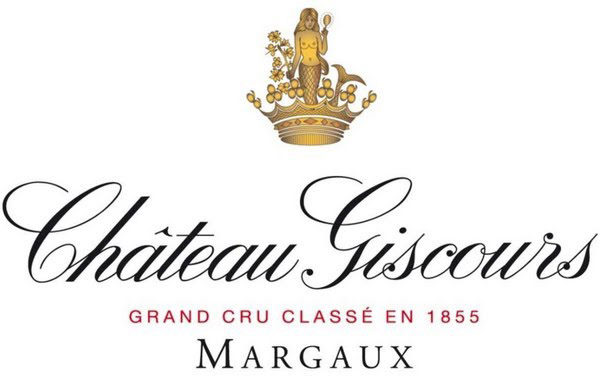
The Estate
Giscours has a long, rich history, which can be traced back to the 14th century. At that time, it was a defensive tower overlooking a wild and inhospitable region. The real beginning came in 1552, when Pierre de Lhomme, a wealthy Bordeaux draper, bought a nobleman’s house called “Guyscoutz”. He proceeded to turn it into a vast estate and planted the first vines. Wine production was launched and each of the rich merchant’s successors made their own contribution to this magnificent building. It was in the 19th century under ownership of the Pescatore and Cruse families that Giscours gained much of its finery. The château was transformed into a neoclassical palace; architect Eugene Bülher and the production facilities were modernized with the construction of huge buildings, including the famous “Ferme Suzanne”.
Located in the Margaux appellation, within the communes of Labarde and Arsac, the exceptional terroir of Giscours possesses all of the qualities required to produce a great wine. The soil components are ideal; 3 magnificent gravel hilltops deposited by the Garonne at the beginning the Quaternary era are one of the key features. The gravel plays a vitally important role, reflecting the sun’s rays and maintaining a stable temperature during the night, thereby providing ideal conditions for the ripening of the grapes. The topography and gentle climate are other beneficial factors. This subtle balance gives the terroir its undeniable finesse.

Château Giscours, Margaux 3ème Grand Cru Classé
President: Eric Albada Jelgersma
General Manager: Alexander van Beek
Technical Director: Didier Forêt
Soil: Deep gravel from the Garonne river and sand from the Ice Age
Production Area: 94 ha
Grape Varieties: 60% Cabernet Sauvignon – 32% Merlot – 5% Cabernet Franc – 3% Petit Verdot
Average Age of Vines: 10-25 years (50%) +25 years (33%) 4-10 years (15%)
Plant Density: 8,330-10,000 stocks/ha
Viticulture: Regular soil working, traditional thinning, and manual leaf removal
Pruning: Double Guyot
Harvest: Hand-picking followed by hand sorting
Average Yield: 40-45 hL/ha
Vinification: In concrete and stainless-steel, thermoregulated tanks. Pumping over varies according to the lots. Temperature during alcoholic fermentation is 26-28°C. Vatting period lasts 18-28 days. Horizontal pneumatic and vertical mechanical pressing.
Aging: 15-18 months in 100% French oak barrels (fine grain and medium toast). 50% new oak, 50% oak of 1 wine. Racking every 3 months with candle. Egg white albumen fining.
Alcohol Content: 13-13.5%

La Sirène de Giscours Margaux
Overview: Just like Château Giscours, with whom it shares the terroir, the second wine is envisioned in the vineyard in the Spring by the vineyard’s technical team and crafted in the cellar to reveal its full identity and elegance. Viticulture and winemaking are done with the same level of precision, nevertheless La Sirène de Giscours is focused on achieving a more approachable, fruitier, and seductive style.
Soil: Deep Garonne gravel
Surface Area: 95 hectares
Grape Varieties: 58% Merlot, 24% Cabernet Sauvignon, 11% Cabernet Franc, 7% Petit Verdot
Harvest: September 26-October 20
Vinification: Manual and visual sorting of the grapes. Concrete and stainless steel tanks. Maceration lasts 30 days at 28°C.
Aging: Aged for 12 months in French oak barrels, 30% new wood.



